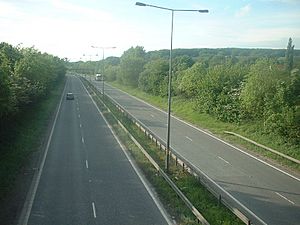Dual carriageway facts for kids

A dual carriageway is a special type of road designed to handle lots of traffic safely. Imagine a big road where cars going in one direction are completely separated from cars going the opposite way. This separation is usually a barrier, a strip of grass, or even just a wide painted line.
Most dual carriageways have at least two lanes for each direction of travel. This helps traffic flow smoothly and reduces the chances of accidents. Unlike some other big roads, dual carriageways usually don't have a 'hard shoulder'. A hard shoulder is a special lane on the side where cars can pull over if they have a flat tire or a problem.
Contents
What Makes a Dual Carriageway Special?
Dual carriageways are built to make travel faster and safer, especially for long journeys. They help keep traffic moving by giving vehicles plenty of space.
Separated Traffic Flow
The main feature of a dual carriageway is its separation. This means cars going north, for example, are on one side of the road, and cars going south are on a completely different part. This separation prevents head-on collisions, which are very dangerous. It also makes it easier for drivers to focus on their own direction of travel.
Lanes for Each Direction
These roads usually have at least two lanes for traffic going in one direction. This allows slower vehicles to stay in one lane while faster vehicles can use another to pass safely. This design helps reduce traffic jams and makes journeys quicker.
No Hard Shoulder
Many dual carriageways do not have a hard shoulder. This means if a driver has a problem with their car, they might need to stop in a live lane or find a safe spot off the road. It's important for drivers to be extra careful on these roads.
Dual Carriageways Around the World
Different countries have different names for dual carriageways. In some places, they might be called divided highways or expressways. No matter the name, their purpose is the same: to move traffic efficiently and safely.
Examples from Different Countries
- In Colombia, many highways are dual carriageways, like parts of Route 25.
- The Clara Barton Parkway near Washington, D.C. in the United States is another example.
- In Germany, they have famous roads called Autobahns, which are often dual carriageways.
- Spain uses them for major routes, sometimes with special barriers called Jersey barriers.
- Ireland also has modern dual carriageways, like sections of the N11.
- You can find them in Canada (like Highway 401), Australia (like the Eastern Freeway), and many countries in Asia like Singapore, Malaysia, and Thailand.
Why Are Dual Carriageways Important?
These roads play a big role in connecting cities and towns. They help people travel for work, school, or holidays.
Improving Safety
By separating traffic, dual carriageways significantly reduce the risk of serious accidents. Drivers don't have to worry about oncoming traffic in the same way they would on a single road.
Handling More Traffic
With multiple lanes in each direction, these roads can handle a much larger volume of cars. This is crucial for busy areas and for long-distance travel, helping to prevent congestion.
Faster Journeys
Because traffic flows more smoothly and safely, journeys on dual carriageways are often much faster than on other types of roads. This saves time for everyone.
Images for kids
-
Freeway of Route 25 between Tuluá and Andalucía, Valle del Cauca, Colombia. In 2014 there were 2,279 kilometers of dual carriageway highways in Colombia.
-
Clara Barton Parkway outside Washington, D.C..
-
Italian autostrada A4 Serenissima near Venice.
-
The autovía A-5 outside Madrid. It is just a duplication of the old National Road 5.
-
Savery Avenue in Carver, Massachusetts was the first divided highway in the U.S.
-
Highway 401, in Ontario, Canada, uses a divided highway, collector / express system to separate local traffic from longer-distance travellers.
-
The Eastern Freeway, a typical dual carriageway in Melbourne, Australia.
-
The Pan Island Expressway in Singapore.
-
Thailand Route 12 single carriageway with a hard shoulder in Phetchabun.
-
AH1, AH2 and Thailand Route 32 in Ayutthaya.
-
Turkish state road D 750 at Konya junction. Toros Mountains in the background.
-
Otoyol 2 near Ali Sami Yen Stadium, İstanbul.
-
Vijayawada-Guntur Expressway in India.
-
A portion of the North Luzon Expressway in Bulacan, Philippines, before the integration with SCTEX.
-
A portion of Subic–Clark–Tarlac Expressway in Bataan.
See also
 In Spanish: Autovía para niños
In Spanish: Autovía para niños

































